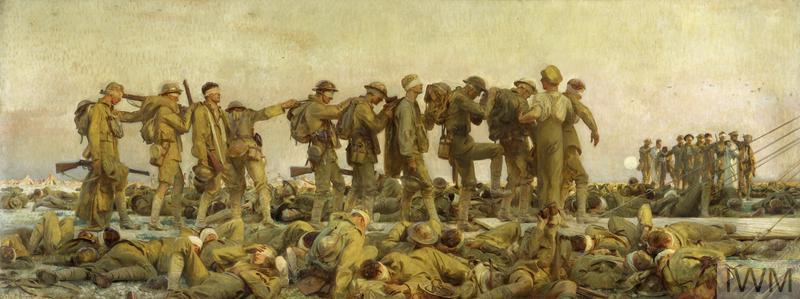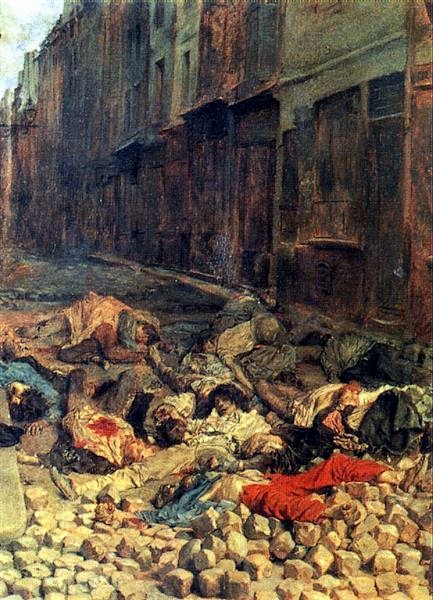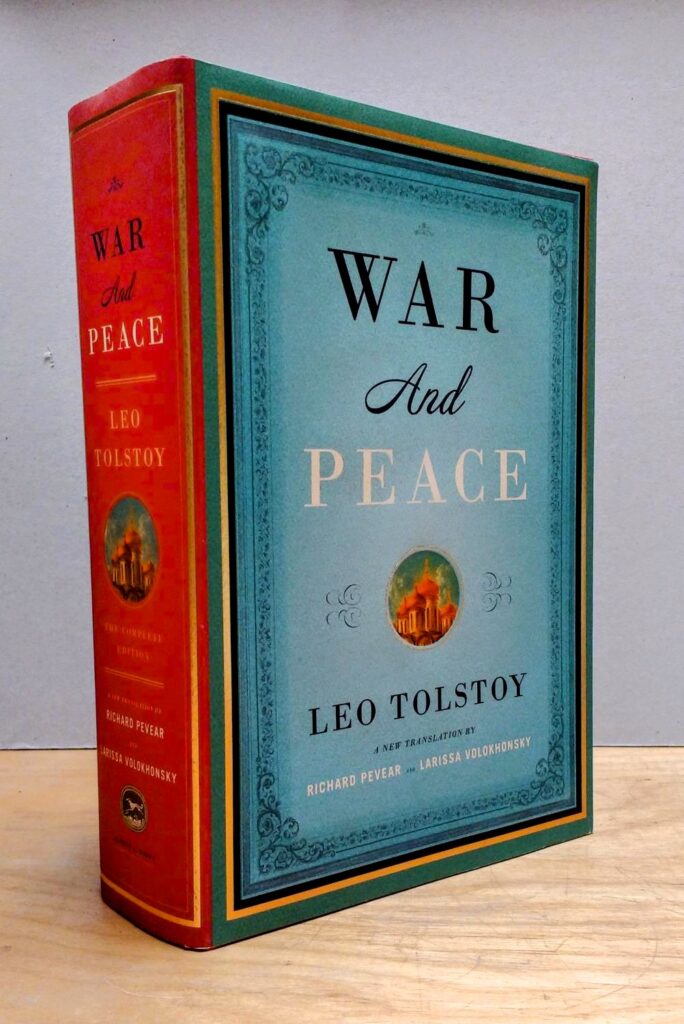By Yousif Al Hamadi
Throughout history, artists, writers, musicians, and filmmakers played an essential role in portraying wars. However, when their work became more authentic and realistic, it became difficult to be accepted by the public and the authorities. Generally, this is because of the amount of destruction represented by the bloodshed of wars, such as the paintings created during the French Revolution in the nineteenth century; likewise, the written novels about the invasion of Russia by Napoleon Bonaparte. Similarly, the symphonies composed during the Second World War were filled with grand-sounding intense and explosive sounds reflecting the state. Film directors also used their medium to portray the aftermath of the Second World War in the same sense, such as the Neorealist Italian films.

The continuous improvements in technology during the nineteenth century affected human interaction and the mass production of media. It made an exchange of ideas related to art by the public widely applicable and accessible. Additionally, it transitioned from emphasizing inspiration to the primacy of the individual that addresses situations in a direct manner, such as the transition from idealism to the realist representation (Barris, 2012).
Nevertheless, the firsthand experience and observation of war from people during this period led to a memorable practice from many talented individuals, which were acknowledged and framed as representations of war. Some of them had characteristics of heroism, tragedy, victory, hostility, or resignation. However, most of them were incomplete regarding the experience and conflicts showing symbolic or ideological representations. They were influenced by regimes of authority over knowledge, power, and the processes of subjectivity (Baraban, Jaeger and Muller, 2012: 2).
Painting
Realist artists tried to be neutral in observing and describing situations and events. Their paintings did not portray beauty, fulfillment, or inspiration but tried to copy scenes like the output of photography, even if the settings were horrific (Herman, 1996: 9). For example, the French paintings Liberty Leading the People (1830) by Eugene Delacroix (1798-1863) about the three days of fighting, which followed by the abdication of the last Bourbon king, Charles X, from the throne in 1830, and Memory of Civil War (1848) by Ernest Meissonier (1815-1891) about the French National Guard preventing the opposing workers in 1848. Both represent occasions in the French Revolution, but Meissonier’s painting is indeed bloodier than Delacroix’s (Barris, 2012).

Delacroix worked on the Liberty Leading the People for three months, using symbolism to capture the event. It shows a half-nude female figure dominating a big painting (2.6m x 3.25m) in front of a crowd of revolutionists presenting the idea of liberty. Her loose dress and the falling red robe from her shoulder show her as the Greek sculpture Winged Victory of Samothrace (c. 190 BCE). She is also wearing a red liberty cap, the one famously worn by the French workers at the time. Liberty is a fighter, raising the national flag of France in her right hand and a gun in the other. It is a bright painting in which the brown and black tones are separated around her, and the figures are composited like a pyramid suggesting victory and revolution (Zelazko, 2017).

On the other hand, Meissonier used dark, unpleasant violet and reddish tones of colors full of suffering. The Memory of Civil War shows dead bodies with their limbs lost besides a barricade of stones in the center of Paris. The painting is realistic in comparison to Liberty Leading the People. It does not contain symbols or posing rhetoric figures, except for the colors of the national flag. Moreover, the painting size is small (29cm x 22cm), painted with watercolor on the spot. Meissonier paid attention to every detail, such as the stones and the opposing workers, but it is not like Delacroix’s painting; it does not have liberty, dead bodies without individuality (Francois, 2018). Meissonier represents his life experience. He served as a national guardsman, fought the rebels, and experienced the horrific loss of lives during the civil war (Zarzeczny, 2013).
Literature
Realist literature followed the same path as paintings. Similarly, it received adverse critical reactions initially but acquired a general acceptance in less than a decade and spread throughout Europe and America (Herman, 1996: 10). War and Peace (1869) by the Russian writer Leo Tolstoy (1828-1910) is an example of realist literature. It is an excellent representation of war through an enormous novel, representing five aristocratic Russian families facing the threat of the French invasion at the beginning of the nineteen century. It is a historical fiction, narrating Napoleon’s victory at the Battle of Austerlitz in 1805. It ends with the invasion of Russia in 1812, including a collection of events in France, St. Petersburg, and Moscow. However, the battle scenes are represented as chaos where military generals think they can predict future events or circumstances, while it is impossible to do so (Etyang, 2009).

Additionally, The War and Peace includes Several real people. It portrays Napoleon as an ineffective but amusing person. It also depicts Tsar Alexander the First as a person coining impressive phrases and concerns about how historians will describe him (Etyang, 2009). There is no hero or heroine, and the narrator is passing on characters telling the reader about their thoughts and feelings following the third-person narrative technique (Hensher, 2016). The line between fiction and history is undistinguished to get the reader closer to the truth, as Tolstoy states in the opening of the third volume. For accuracy, he adds dates to give an account of the particular order of events, which eventually became a major thing in the realist literary movement (Etyang, 2009). War and Peace is a great novel that has been a source of inspiration for many. It has been adopted into film, television drama, and theatre.
Music
The idea of realism has been questionable in music as well. During the nineteenth century, composers saw music as romantic and unrealistic art. The musicologist Carl Dahlhaus (1928 – 1989) defined realism in music as
The totality of concrete reference to the common experience of human beings as embodied in all the formal elements of musical art
Dahlhaus, 1985: 13
Symphony No. 7 (Leningrad) (1941) is a realist piece of music by the Russian composer Dmitri Shostakovich. The Nazi invasion of Russia influenced it in 1941. Shostakovich worked on the symphony with intensity under raids of German planes and in a grim atmosphere. In this siege, more than half a million people died, and Shostakovich was forced to evacuate twice. Even in these terrible conditions, he continued working on the symphony and finished it in December of the same year (Classic FM, 2018).
YouTube · Иван Шариков
May 9, 2020
Leningrad Symphony was setting big movements of more than 70 minutes. The opening, Allegretto (War), is around 30 minutes at a determined C major. The section in the center takes an Offenbach theme and turns it into a continually repeated rhythm that overwhelms the C major theme. It is followed by Moderato (Memories) of strings, harsh woodwinds, and Adagio (Native Field) with strong emotional strings and clear brass. The closing Allegro (Victory) returns to the opening style with glorious themes in an endless C major climax (Leonard, 2018). Leningrad Symphony was banned in 1948 by the Soviet Union, attempting to make it disappear, but it stayed in the minds and hearts of Russians (Service, 2016).
Film
The conception of realism was also adopted in the film industry. Its early method in art and literature influenced filmmakers from the 1920s, including the British Documentary Movement, Italian Neorealism, and other new film movements. In the 1940s and 1950s, French film critic Andre Bazin (1918-1958) celebrated the films with Italian Neorealism relating to indexes of real locations and people. Additionally, he is marked by a preference for specific cinematography techniques to retain reality. Bazen also compared Neorealism with montage-driven films such as those by Soviet film director Sergei Eisenstein (1898-1948) and didactic wartime propaganda films (Kuhn and Westwell, 2012: 344-345).
Paisan (1946), written, produced, and directed by the Italian Roberto Rossellini, is a relevant example of how realist films represented wars. The film was produced in the aftermath of the Second World War, revealed in six stories as separate episodes with different leading characters, adopted by recent Italian stories. Each represents a degree of humanity and familiarity between Italian and American liberators. The order of the events and the geographic location follow the path which was taken by the invasion of the Allies through six different cities in Italy (Bondanella, 1993: 64-65).
Paisan is a newsreel documentary because of the way the episodes are organized, the accuracy of the arrangement of events with respect to history, in addition to a voiceover introducing each episode with factual information. Moreover, Rossellini combines newsreel footage and fiction, looking like television coverage. He provided some Neorealist techniques such as using non-professional actors, actual locations and the camera kept low, not higher than a crouched person (Bondanella, 1993: 65-66). Paisan has been counted as a great representation of war, receiving positive feedback, and criticism, and winning several awards.
Conclusion
The development of technologies during the nineteenth century contributed to the development of media production and consumption in all its fields. Artists were trying to represent their ideas, and wars in particular, in a more realistic way, away from symbolism. This shift in the style of representation can be seen by comparing Eugene Delacroix’s romantic painting Liberty Leading the People and Ernest Meissonier’s realistic painting Memory of Civil War, both of which were painted during the French Revolution, but Delacroix relied on symbolism to represent his ideas, while Meissonier represented the scene photographically revealing the extent of the bloody horror.
The Realist movement also influenced literature, such as Leo Tolstoy’s War and Peace, which presented historical details with precise chronological realism, depicting the thoughts and decisions of the military leaders and generals who participated in the war. Also, music acquired an aspect of realism in the representation of wars. Symphony No. 7 (Leningrad) by Dmitriy Shostakovich is an example of this, as it was composed in light of the German strikes on Russia during World War II, exhibiting realism in the C major theme, using specific instruments to reach the realist feel. Finally, films were not without realism in representing wars, especially during the twentieth century. The most prominent movement was Italian neorealism in the aftermath of World War II until it had its own characteristics and settings that distinguished it, providing a successful film model that won many awards internationally.
Bibliography
Barris, R. (2012). Politics, Art and Realism. Radford University. Available at: https://www.radford.edu/rbarris/art216upd2012/realism%20in%20the%2019th%20century.html [Accessed 31 Oct. 2018].
Bondanella, P. (1993). The Films of Roberto Rossellini. Cambridge: Cambridge University Press.
Classic FM. (2018). The Story Behind Shostakovich’s Leningrad Symphony. Classic FM. Available at: https://www.classicfm.com/composers/shostakovich/guides/story-behind-shostakovich-leningrad-symphony/ [Accessed 31 Oct. 2018].
Dahlhaus, C. (1985). Realism in Nineteenth-Century Music. Cambridge: Cambridge University Press.
Etyang, P. (2009). Leo Tolstoy: War and Peace. Academia.edu. Available at: https://www.academia.edu/6788963/Leo_Tolstoy_War_and_Peace [Accessed 31 Oct. 2018].
Francois, V. (2018). The Barricade, rue de la Mortellerie, June 1848. Louvre Museum. Available at: https://www.louvre.fr/en/oeuvre-notices/barricade-rue-de-la-mortellerie-june-1848 [Accessed 31 Oct. 2018].
Hensher, P. (2016). War and Peace: the 10 things you need to know (if you haven’t actually read it). the Guardian. Available at: https://www.theguardian.com/books/2016/jan/22/war-and-peace-guide-philip-hensher [Accessed 31 Oct. 2018].
Herman, L. (1996). Concepts of Realism. Columbia: Camden House.
Jaeger, S., Baraban, E., & Muller, A. (2012). Fighting Words and Images: Representing War Across the Disciplines. Toronto: University of Toronto Press.
Kuhn, A., and Westwell, G. (2012). A dictionary of film studies. Oxford: Oxford University Press.
Leonard, J. (2018). Dmitry Shostakovich: Symphony No. 7 in C major (Leningrad), Op. 60. AllMusic. Available at: https://www.allmusic.com/composition/symphony-no-7-in-c-major-leningrad-op-60-mc0002366734 [Accessed 31 Oct. 2018].
Service, T. (2016) War music: the humanity, heroism and propaganda behind Shostakovich’s Symphony No 7. the Guardian. Available at: https://www.theguardian.com/music/2016/jan/02/war-music-the-humanity-heroism-and-propaganda-behind-shostakovich-symphony-no-7 [Accessed 31 Oct. 2018].
Zelazko, A. (2017). Liberty Leading the People | Description, History, & Facts. Encyclopedia Britannica. Available at: https://www.britannica.com/topic/Liberty-Leading-the-People [Accessed 31 Oct. 2018].
Zarzeczny, M. (2013). Top 10 Disturbing Paintings of Modern Historical Atrocities. TopTenz. Available at: https://www.toptenz.net/top-10-disturbing-paintings-of-modern-historical-atrocities.php [Accessed 31 Oct. 2018].